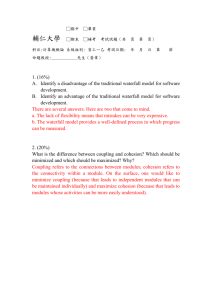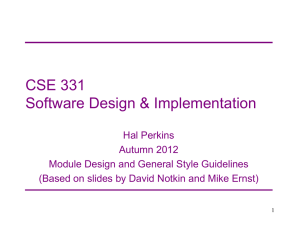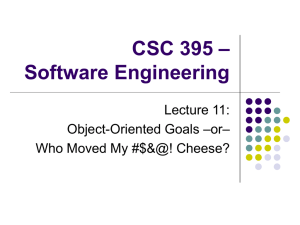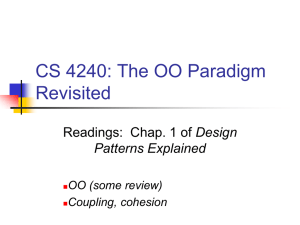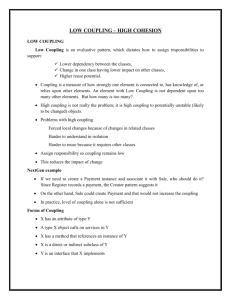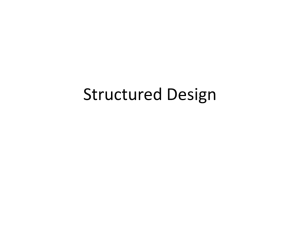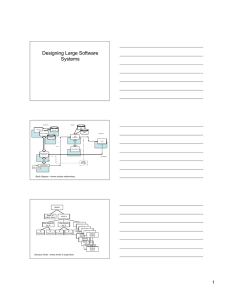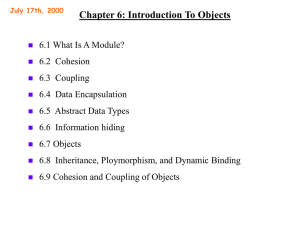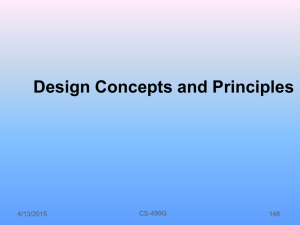Ch 7: From Modules to Objects
advertisement
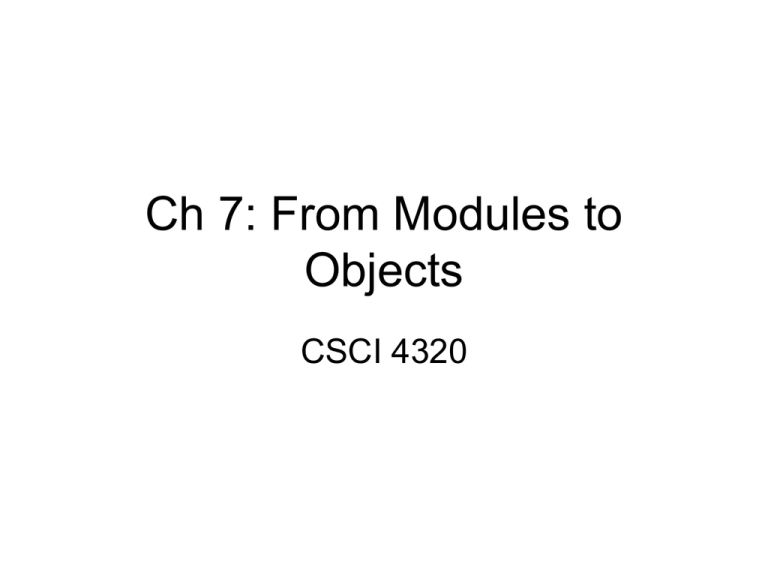
Ch 7: From Modules to
Objects
CSCI 4320
What is a Module?
• Sequence of program statements, bounded by
boundary elements, having an aggregate
identifier
– “Boundary elements”
• {...}
• begin . . . end
– “Aggregate identifier”
• A name for the entire module
• Examples
– Header files
– Class
– Procedure/ Method
Why Use Modules?
•
•
•
•
Understandability
Corrective Maintenance
Enhancements
Reuse
Operation, Logic & Context of Modules
• Operation:
– WHAT a module does
– “Compute the Square root of the argument”
• Logic
– HOW the module performs its operation
– “Use Newton’s method of computing the square root”
• Context
– SPECIFIC USE of a module
– Module m is used to compute the square root of an
integer
Design of Computer
• A computer architect decides to build an ALU,
shifter, and 16 registers with AND, OR, and NOT
gates.
Figure 7.1
Design of Computer (contd)
• The architect designs 3 silicon chips
Figure 7.2
Design of Computer (contd)
• Redesign with one gate type per chip
Figure 7.3
Computer Design (contd)
• The two designs are functionally equivalent
– The second design is
•
•
•
•
Hard to understand
Hard to locate faults
Difficult to extend or enhance
Cannot be reused in another product
• Modules must be like the first design
– Maximal relationships within modules, and
– Minimal relationships between modules
Structured Design for Modules
• Design your modules to have HIGH
cohesion and LOW coupling
• Cohesion
– Degree of interaction WITHIN a module
• Coupling
– Degree of interaction BETWEEN two modules
Levels of Cohesion
•
•
•
•
•
•
•
Coincidental (bad)
Logical
Temporal
Procedural
Communicational
Functional
Information (good)
Coincidental Cohesion
• A module performs
multiple, completely
unrelated operations
• May result when smaller
modules are lumped
together
• Difficult to maintain &
enhance
• Cannot reuse
func A (p1, p2, p3, p4)
{
1. Print p1
2. Reverse characters of p2
3. Add 7 to p3
4. Convert p4 to a float
}
Logical Cohesion
• A module performs a
series of related
operations, one of which
is selected by calling the
module
• Interface is difficult to
understand
• Code for more than one
module may be
intertwined
func B (opt, p1, p2, p3)
{ x:=0
if opt = 1 or 2
x := p1 + p2
if op = 2
x := x + p3
if op = 3
x := p3
if op = 4
x := 4
}
Example: A module that performed 13 different operations; its
interface contained 21 pieces of data
Temporal Cohesion
• A modules performs a
Initialization Procedure()
series of operations
{
related in time
• The operations are related
1. Open old master file
weakly to one another but
2.
Print
File
more strongly to
3. Initialize District Table
operations in other
modules
4. Read Sales Table
• High chance of regression
}
fault : Changing Sales
Table structure affects
multiple modules
It is better to have Read_sale_table Operation with all other
methods that use the Sales Table
Procedural Cohesion
• A module performs a
series of operations
related by the sequence
of steps
• Better than temporal
because the actions have
something to do with
each other other than the
fact they are performed at
the same time.
• However, the connection
is still weak
Procedure Update()
{
1. Read part number from
Database
2. Update repair record in
Maintenance File
}
Communicational Cohesion
A module
1.
2.
Performs a series of
operations related by
the sequence of steps
to be followed
All the operations are
performed on the same
data
Procedure Save (Record)
{
1. Update Record in
Database
2. Write Record to Audit
Trail
}
Functional Cohesion
– A module that
performs exactly one
operation or achieves
a single goal
– Maintenance is easy
to perform
Proc GetTemp()
{
Get Temperature of
Furnace
}
Informational Cohesion
A module
– Performs a number of
operations, each with its
own entry point,
– Independent code for
each operation, all
performed on the same
data structure.
– Example:
– Abstract Data Type
– Class
Coupling
The degree of interaction BETWEEN two modules
– Content Coupling (bad)
– Common Coupling
– Control Coupling
– Stamp Coupling
– Data Coupling (Good)
Content Coupling
– One module directly references the contents of another
– Example:
– Uses GOTOs to reference different parts of modules
• Result
– : Almost any change to module q, even recompiling q with a new
compiler or assembler, requires a change to module p
Common Coupling
– Both modules have access to the same global
data
– Does not communicated by passing arguments
– A module can change the value of global data
and it affects the other module
– Difficult to reuse since the same list of global
values must be used in future products
– A module may be exposed to more data that
strictly necessary
Control Coupling
– One module passes an element of control to the other
module
– (i.e., one module explicitly controls the logic of another)
– Example
– Control is passed when a function code is passed to a module
with logical cohesion
– DrawPicture (code) – The picture drawn depends on code
– BAD CASE: If module P calls Q and Q informs P of what
action to take
– Q says “I am unable to complete my task” therefore write
“ABC123”
Stamp Coupling
– A data structure is passed as an argument, but the called
module only operates on some of the individual
components of the structure
– Example:
– Passing a student record with name, address and ssn but only
using Name
PrintName (Student)
– Passing an employee record with home # and salary but only
calculating federal tax
CalculateTax(Employee)
• Passing more data that necessary can lead to
uncontrolled data access
Data Coupling
– Every argument is either a single argument or a
data structure in which all elements are used by
the called module
– DisplayArrivalTime (flightNumber)
– Multiply (num1, num2, result)
Data coupling is a desirable goal
